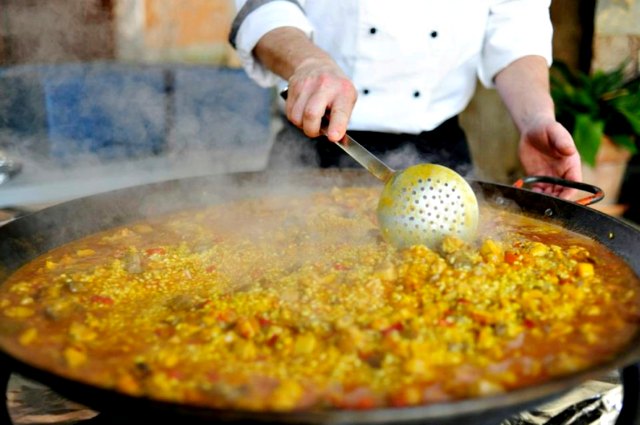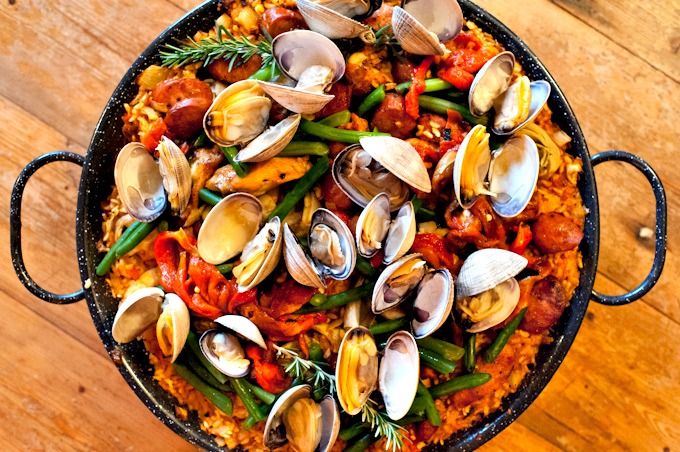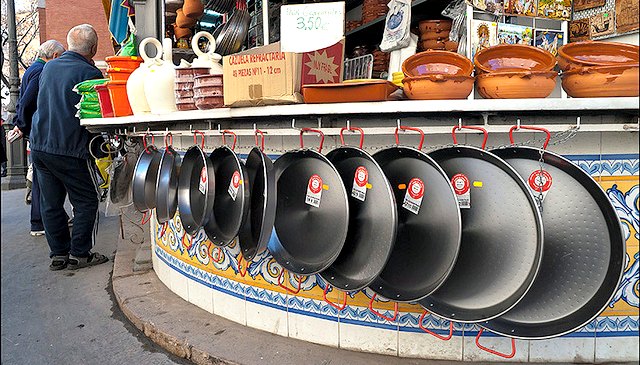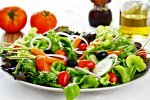The Secrets of Paella
The authenticity of paella is gauged by the community it builds. What better way to enjoy your friends than to sit around the communal paella and share it together? Is that not what life is all about?
Paella originated in the countryside long ago. Farmhands made a fire in fields at lunchtime and simmered the local short grained rice in a flat pan. They added whatever edibles were at hand – snails might be added as well as artichokes and other local vegetables; or perhaps a stray chicken or a rabbit caught in the fields. Along the shore fishermen would embellish their paellas with fish and seafood.
As tourists from other parts of Spain vacationed on the Mediterranean coast in the summer, the dish spread throughout other regions of Spain. Variations have evolved to include locally available produce. In Sevilla and Cádiz they add big prawns and langostinos. Along the Costa del Sol, mussels, prawns, ñora peppers and lemons became favored ingredients.
Today paella has universal appeal with literally hundreds of regional variations. Other than a couple of key ingredients, it is the preparation that makes the difference. But do not be intimidated, if you use authentic ingredients to start with, you do not need to be a master chef to prepare something delightful for your friends and family. You will have fun experimenting - it can even be a common project, with everyone pitching in to prepare a perfect feast.

Useful tips
- Pay attention to your broth, this is the soul of the paella – make it rich and flavorful with fish or chicken stock, shrimp shells and seasonings (including bouillon cubes if you need the flavors strengthened).
- Use the correct strain of rice. It is the difference between passable and exquisite paella. Firm and absorbent rice is the watchword. Spaniards always use short-grained rice, such as Bomba or Calasparra – it absorbs lots of rich of broth with each grain remaining distinct. Do not substitute creamy arborio; sticky Asian short grain; fragile and aromatic basmati; or regular long grain American rice, which is not absorbent.
- Use real Spanish saffron. In harder times, Spaniards substituted "colorante" a yellow artificial coloring with a turmeric base – but it is not the same thing. It will not have the deep aroma and flavor. We have reasonably priced our premium saffron – there is no need for compromise.
- The fire must be very hot to start with, the heat being continually reduced during cooking. Ideally it should be prepared on a wood or charcoal fire. You can improvise with what cooking surface you have available – a gas paella grill accomplishes much the same effect.
Remember, paella is a simple rice dish, and it is yours to prepare. If you use authentic ingredients, there is no such thing as failure – each one is unique. So keep it simple, but do not "cut corners".
You may be also interested in...
see also...
Paella recipes: There are literally hundreds of paella recipes and every cook has their own favorite recipe. At Spain-recipes. com we've collected some of our favorite paella recipes, we recommend trying them all to discover the full variety of Spanish Paella!!!
Which Paella pan should I use? After receiving many inquires on what are the right size and characteristics for a paella pan, we've made a bit of research, and retrieved some information on that issue. We usually use regular, 15-inches paella pan, but we've managed to find some other sizes also. So if you want to find out which paella pan size suits you best, just keep reading...




